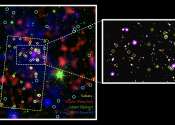Tune your radio: Galaxies sing when forming stars
A team led from the Instituto de Astrofísica de Canarias (IAC) has found the most precise way ever to measure the rate at which stars form in galaxies using their radio emission at 1-10 Gigahertz frequency range.









